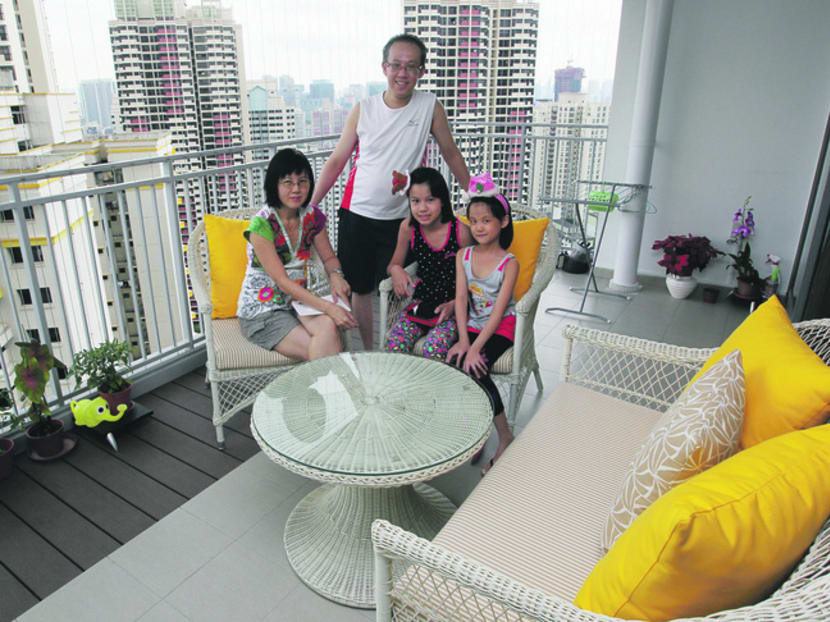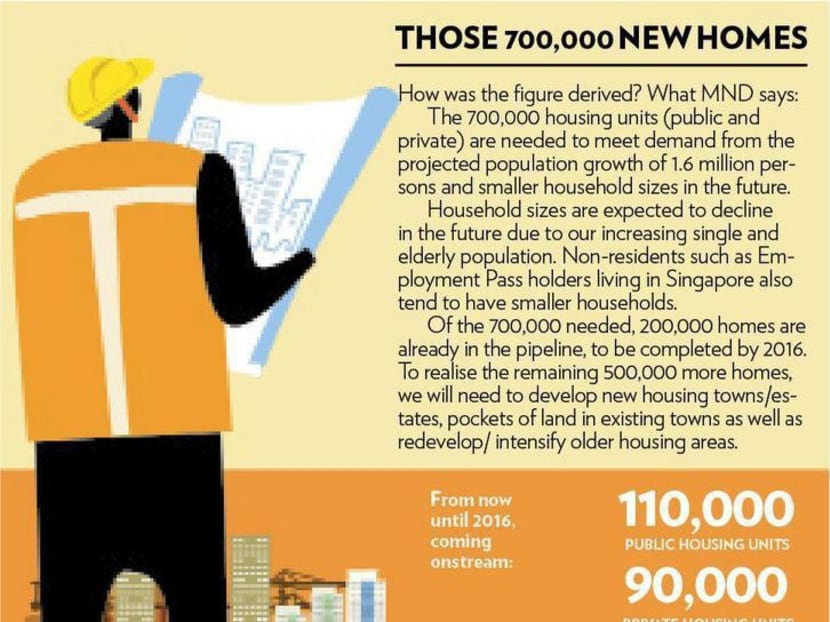The great HDB flat redesign
As soon as IT consultant Mr Oh Hian Leong and his family stepped into their 32nd-floor unit at The Peak@Toa Payoh, his children, aged nine and 11, were taken with the balcony view that the flat came with.


As soon as IT consultant Mr Oh Hian Leong and his family stepped into their 32nd-floor unit at The Peak@Toa Payoh, his children, aged nine and 11, were taken with the balcony view that the flat came with.
The five-room Design, Build and Sell Scheme (DBSS) flat has afforded them a kind of lifestyle that public flats of older design did not.
“This is much better, we can enjoy the outdoors in our own home. We have breakfast and snacks, even eat durian, at the balcony. We also read there,” said the 48-year-old dad. Their previous HBD flat had only a tiny corridor outside for the kids to play in, he said.
Balconies may still not be a standard feature for the majority of public housing flats, but the option is now being offered at selected Build-to-Order (BTO) projects — generally where the flats enjoy good views, says the Housing Board — as a greater range of options are made available to today’s home-buyers.
Over the next 20 years, housing supply is being ramped up — to the tune of 700,000 more homes by 2030, if need be — to ensure sufficient quantity to meet demand from a growing population. At the same time, affordability remains a fundamental priority of public housing. But there is also the simultaneous challenge of fulfilling Singaporeans’ yen for better-quality HDB homes that match their rising aspirations.
Can all three challenges be met without significantly trading off on one or the other?
QUALITY OF NEW FLATS
The Ohs were glad their new flat came ready with fittings such as kitchen and toilet cabinets, as well as floor tiles — unlike the flats of old which came as-is, in bare concrete.
“It was a pain the last time when we had to do a lot of major works,” recalled Mr Oh, who was stressed out liaising with contractors. “This is definitely more convenient. I even had a choice of timber over the white floor tiles for our master bedroom.”
At the Pinnacle@Duxton — the HDB’s flagship project to “redefine the typology of public housing” — residents like Mr Sebastian Lee, 47, delight in the “private-housing-like” vibe of the modern units.
The optician, who lives in a three-bedroom flat there, said: “The top-to-floor windows made it look stylish, and the whole living room became brighter. Generally, the whole look is much classier than the typical older HDB flat, which I’m very happy about.”
Mr Lee, who previously had a flat in Tampines, also noted how his new flat came with premium finishings such as parquet flooring, wooden bedroom doors and sliding toilet doors.
VIEWS, PRIVACY AND FITTINGS
It is not only premium flats that show a marked improvement from flats of yesteryear, and this is a sign of changes that yet may be.
HDB flat windows today are larger, providing “more natural light and ventilation”, while quality has improved with better construction material and processes, for instance.
The evolution of HDB flat design over the years also has gone from simple rectangular corridor-facing units, to layouts that give residents “better views and greater privacy”, noted the HDB. Buyers also get more choice. BTO flats come with the Optional Component Scheme, which lets flat-buyers choose components such as the internal doors, floor finishes and sanitary fittings.
With more such features, the purchase price of the flat goes up. But the advantage, pointed out Madam Shimah Ar, who lives in new BTO development Yishun Spring, is that the extra cost can be paid out of their Central Provident Fund accounts.
“Which is good because a lot of young couples here are not cash-rich,” said the teacher, who opted for timber doors and flooring in the entire flat, an add-on that cost some S$2,000. In other words, the measure helps ease the cash outlay for families, especially low-income ones, on renovations.
THE DILEMMA OF SPACE
Space, however — both the amount and the use of it — is an issue on which it has proved harder to please everyone. For instance, while residents like the Ohs appreciate extras like balconies, others wish these could be made smaller or done away with so that interior living areas can be bigger.
Many of the residents TODAY spoke to wished for bigger living rooms and bedrooms, as well as larger kitchens so that bigger families can cook — a much cheaper option than eating out.
“It is assumed that the average family eats out, but that’s not true. I think many families still cook and have dinner together at home,” said Mrs Yang Sok Leng, a resident in her 50s at The Peak. “A larger kitchen would encourage more families to cook and eat together — otherwise everyone will just eat on their own and family time is lost.”
Why not, then, give residents more flexibility in determining how they want to use the space within their homes? This is an idea already being tested.
BREAKING DOWN WALLS
At the Pinnacle, for instance, column-free units and removable lightweight internal concrete walls give residents the leeway to change the layout of their homes to suit their lifestyle changes over time.
And at Teck Ghee Parkview, a BTO exercise offered in September, the HDB piloted an “open kitchen” concept giving buyers a choice of whether to have a partition wall between the living/dining area and the kitchen. It will monitor response to see whether to extend this concept to future BTO projects.
(The authority clarified that the reason kitchens of the past seemed larger is they were combined with the dining area — and the current design is in response to many residents who want the areas sectioned off. But as the HDB avoids placing structural columns at the kitchen area, the kitchen walls can be broken down.)
In fact, housing visionaries think that in time to come, walls within HDB flats could be a thing of the past.
Mr Jeffrey Ho, Managing Director of Surbana Urban Planning Group, said a vacant layout could be a possibility seeing as how many young couples now hack down walls and then pick and choose where to erect new partitions in the form of steel sheets or cabinets.
“Who says all the rooms must have walls? The designs of new flats should keep up with the changing lifestyles of young couples. Many of them are blurring the lines of convention by choosing an open concept for their homes,” he said.
MORE ROOM?
Besides playing around with layout, industry experts suggest other ways modern design and technology could maximise the use of space. One example is the “miniaturisation of devices” such as wall LCD panels, said Professor Lye Kin Mun, Deputy Executive Director, Science & Engineering Research Council, A*STAR.
Professor Carlo Ratti of the Massachusetts Institute of Technology (MIT) looks even further afield in resolving this space conundrum. Do away with the need for looking at technological solutions, such as a collapsing bed, he said. Instead, look beyond the home to serve all our needs.
“I believe that a great potential comes from that fact that technology makes us more flexible in doing what we need to do: We can appropriate a Starbucks as an office for a few hours or do emails on the kitchen table. Over a whole city this allows a better, more dynamic use of space — overall with less per capita real estate,”he said.
But at the of the day, what if some families simply want a bigger flat, especially if the family expands?
Mr Hamza, 63, a technician living at Treelodge@Punggol, said: “To have more children, Singaporeans need more space.”
At the same time, some wonder if flat sizes will shrink in future with the need to accommodate more housing for a bigger population. The HDB notes that four-room flats currently form the bulk of new flat supply. The prevalent size of such public housing flats — 90 sq m — “has remained constant” since 1997.
“Currently, there are no plans to adjust the prevalent sizes of each flat type,” said the HDB, adding that Singaporeans could look to how Punggol, which was planned with the future in mind, is “dense but highly liveable with proper sized flats, green spaces and a waterway”.
“In any future review, HDB will take into consideration changes in demographic trends and lifestyle habits, as well as the need to optimise limited land available for housing.”
WITHIN EVERYONE’S REACH, STILL
The bottomline message and reassurance from the HDB: It will regularly review its offerings to meet Singaporeans’ rising aspirations and changing needs.
This will “take into consideration changes in economic conditions, demographic trends and lifestyle habits”, it said. The striving for quality living has won the public housing board numerous international awards.
“In fact, many people feel the look and feel of new HDB flats is very similar to private developments, and international visitors are often unable to distinguish between public and private housing,” it noted.
Some, however, wonder: Will all this come at a cost in the long run — affordability? No, says the HDB.
“With improved infrastructure, flat design and quality, it is only natural that our flats’ values will increase to reflect these multi-dimensional improvements,” said the Housing Board.
“However, the HDB remains committed to provide affordable public housing to Singaporean households now and in the future. When new features are introduced, the HDB will ensure that these features are cost effective and add value to the flat buyers.”
Last year, new BTO four-room flats were priced from S$208,000 inclusive of grants. The HDB reiterated its continued efforts to ensure flats remain affordable: By ensuring an adequate supply; offering a wide range of new flats and flat types, in different locations; pricing new flats substantially below market prices of comparable resale flats; offering various housing grants, and encouraging prudence through financial counselling, for example.
“New generations of Singaporean families can remain assured that there will be a HDB flat priced within their reach, of good quality, and housed within a vibrant community,” said the HDB.






